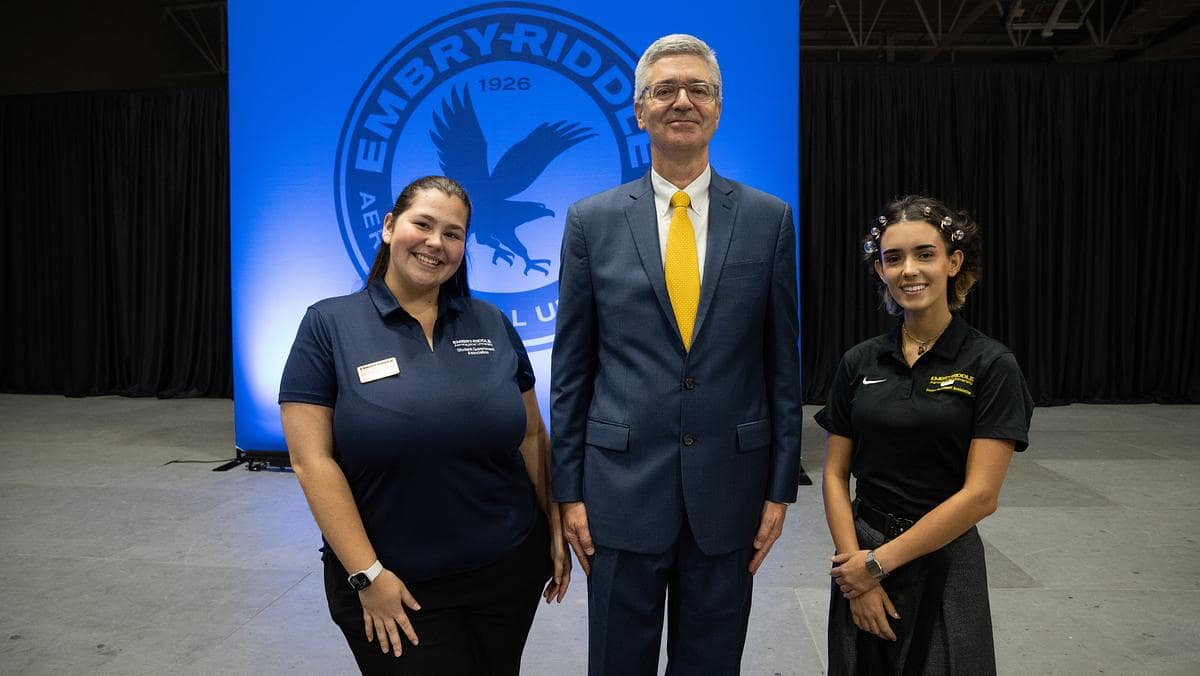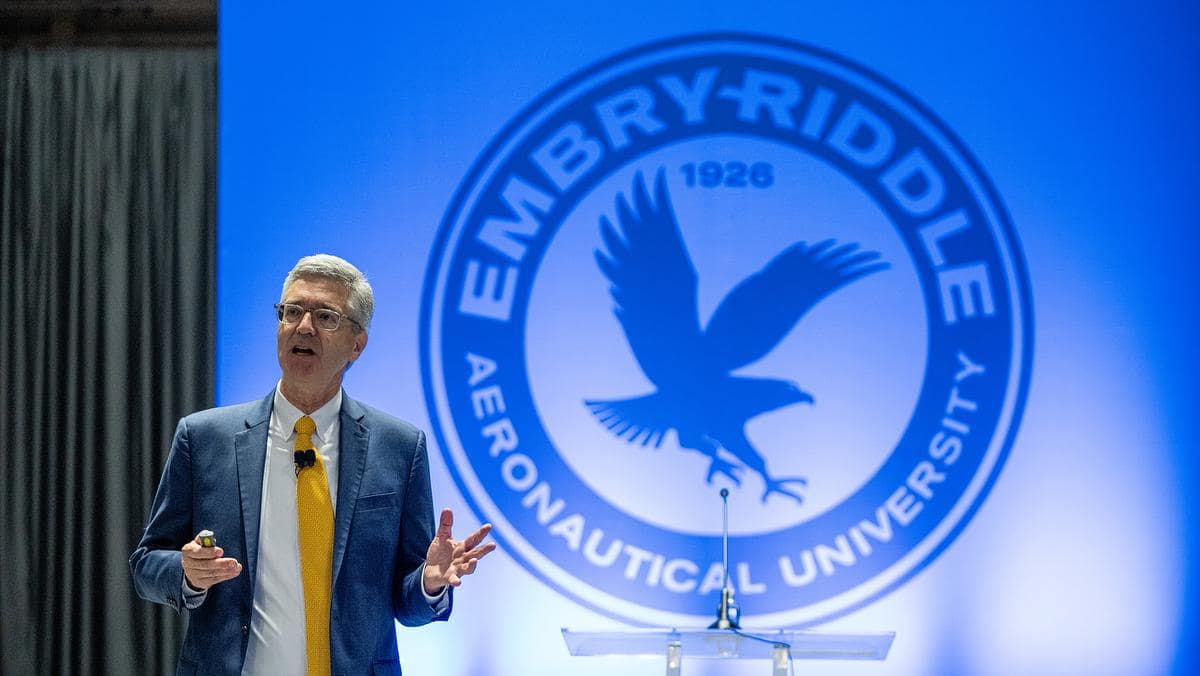Embry-Riddle President Unveils New Strategic Plan

Embry-Riddle Aeronautical University’s new five-year strategic plan, unveiled this month by President P. Barry Butler, Ph.D. during his annual State of the University address, places renewed emphasis on student retention, scholarship funding and enrollments to specific areas such as graduate programs.
During three presentations – for Embry-Riddle’s Daytona Beach, Florida; Prescott, Arizona; and Worldwide campuses – Dr. Butler outlined highlights from the past year and set forth his vision for the future.
In opening the Daytona Beach event, Board of Trustees Chairman Mori Hosseini, an alumnus and supporter since the 1990s, said that Embry-Riddle “is in the best shape it has ever been in its history.”
The university’s 2023-2028 strategic plan aims for even greater heights. Dr. Butler stressed that teamwork will be essential for advancing the university’s goals across five key areas: The Student Experience, Enrollment Management, Academic and Faculty Success, Research and Innovation, and Philanthropy and Alumni Engagement.
“We’re all a part of this,” Dr. Butler said. “We all need to be moving toward what we have defined as success.”
Embry-Riddle’s success starts with its students, he added. “Think about how you can contribute to our vision for 2028 – as an individual, as a unit or department, or as an entire campus,” he said. “You’re the reason we’re so successful.”
Celebrating Key Achievements
Embry-Riddle performs well across most areas, including financial strength, infrastructure, undergraduate enrollments, funded research, state support, strategic communications, faculty hiring and the Research Park’s success in driving innovation to create high-paying jobs. Most of the goals outlined in a prior five-year plan, completed this year, were met, Dr. Butler reported.
Enrollment remains robust overall: Embry-Riddle’s two residential campuses currently serve about 11,500 enrolled students, including 1,300 ROTC students and 720 “scholar athletes,” he said. Those students contributed a combined 42,761 hours of volunteer service over the past year. The Worldwide Campus serves 20,000 enrolled students, with 50% being active military members.
A premier aviation and aerospace institution, Embry-Riddle’s two Flight departments, which maintain a fleet of about 180 aircraft, tallied 198,845 flight or simulation hours, handed out 2,138 certifications and rankings, and completed 264,343 landings this past year, Dr. Butler shared.
The university has seen a 70% growth in revenue over the past 10 years, too. The State of Florida invested $28 million in Embry-Riddle in fiscal year (FY) 2022, and the university’s Philanthropy team raised $21 million. Chairman Hosseini attributed the university’s robust standing to the hard work and dedication of faculty, staff and leadership.
Dr. Butler agreed, adding that the university is making strategic investments in people, programs and infrastructure. Employee salaries, wages and benefits rose by 42.6% between FY 2012 and FY 2024, and they exceed the Consumer Price Index for all Urban Consumers (CPI-U) as well as a key industry benchmark, the College and University Professional Association (CUPA-HR).
Since fiscal year 2013, Embry-Riddle has grown from 360 faculty members to nearly 600, for fiscal year 2024. In recent months, the university also welcomed new leadership in key areas, including Dr. Kelly M. Austin, senior vice president for academic affairs and provost; Kelly Dowling, senior vice president for Philanthropy and Alumni Engagement; and Dr. Dietmar Rempfer, dean of the College of Engineering at the Prescott Campus.
The university has made $663 million in capital investments over the past 10 years, Dr. Butler added. For FY 2014 through FY 2027, the Board of Trustees has invested approximately $1 billion in capital investments. Improvements either underway or on the horizon include an ambitious modernization plan at the Prescott Campus, more on-campus housing and funded projects at the Research Park.

Embry-Riddle President P. Barry Butler presents the 2023 State of the University address. (Photo: Embry-Riddle/David Massey)
Outlining a Vision for 2028
Embry-Riddle’s vision for the future remains unchanged, Dr. Butler said. All of the university’s activities will continue to reflect three overarching goals:
- Be the unquestioned global leader in aviation and aerospace higher education.
- Have a reputation for personal attention to student success.
- Be the definitive source for innovation and excellence in aviation and aerospace education and research.
As examples of these objectives in action, Dr. Butler cited the Center for Aerospace Resilience; the Boeing Center for Aviation and Aerospace Safety; the Center for Space and Atmospheric Research; the Space and Atmospheric Instrumentation Lab (SAIL); and ongoing Research Park outcomes.
The university has met most of its initial strategic goals, Dr. Butler said, but improving student retention will require an even more intense student focus. Students who are strongly engaged in academic projects, competitions and extracurricular activities are more likely to complete their degrees and serve as ambassadors for Embry-Riddle after they graduate, Dr. Butler noted.
Under the 2023-2028 strategic plan, a top-priority goal is to “provide an exceptional student experience that aligns with improved retention and timely graduation.” The plan outlines six specific retention metrics that Embry-Riddle will strive to achieve by 2028. For example, Embry-Riddle will work to increase the retention of first-year residential campus students, from a baseline of about 81%, to 88%. Overall, the university’s goal is to ensure that retention and graduation rates are comparable to other members of the Association of Independent Technological Universities (AITU).
Further elevating Embry-Riddle’s research enterprise and reputation will require increased external research funding as well as additional enrollments to graduate degree programs, Dr. Butler said. Achieving additional nationally ranked programs – and providing strategic communications support for them – is yet another goal.
In addition, although Institutional Financial Support or IFS has increased by 125% since fiscal year 2015, increased scholarship support will be essential to ease financial hardships and keep more students at Embry-Riddle until they graduate.
Toward that end, a critical task under the 2028 plan is to “pursue major gifts to support student scholarships,” especially endowed scholarships consistent with Embry-Riddle’s strategic goals, as part of a comprehensive fundraising campaign spearheaded by the Office of Philanthropy and Alumni Engagement. The university’s Corporate Relations team will also seek a “broader level of engagement with businesses supporting scholarships,” Dr. Butler said.
A Call to Action
Chairman Hosseini welcomed philanthropist Cici Brown, who attended the State of the University address at Daytona Beach and, last year, donated $25 million, along with her husband Hyatt Brown, to establish a state-of-the-art aerospace technology center, to be named in their honor.
The Browns’ generosity inspired matching support from the State of Florida, Hosseini noted, and this year, the state provided another $20 million for a secure facility at Embry-Riddle’s Research Park. “They are investing in you,” Mr. Hosseini pointed out. “They’ve decided you’re worth it.”
Dr. Butler also commended faculty, staff and students, including the university’s new Student Government Association leadership.
Noting that student retention relates closely to personal attention and experiential learning opportunities, Dr. Butler called on all faculty and staff to:
- Show students they are CARED about;
- Make students EXCITED about learning; and
- Encourage students to PURSUE their goals and dreams.
The 2028 strategic plan has a budget of $32.5 million over the next six years, Dr. Butler reported. It can be found online here.

 Ginger Pinholster
Ginger Pinholster